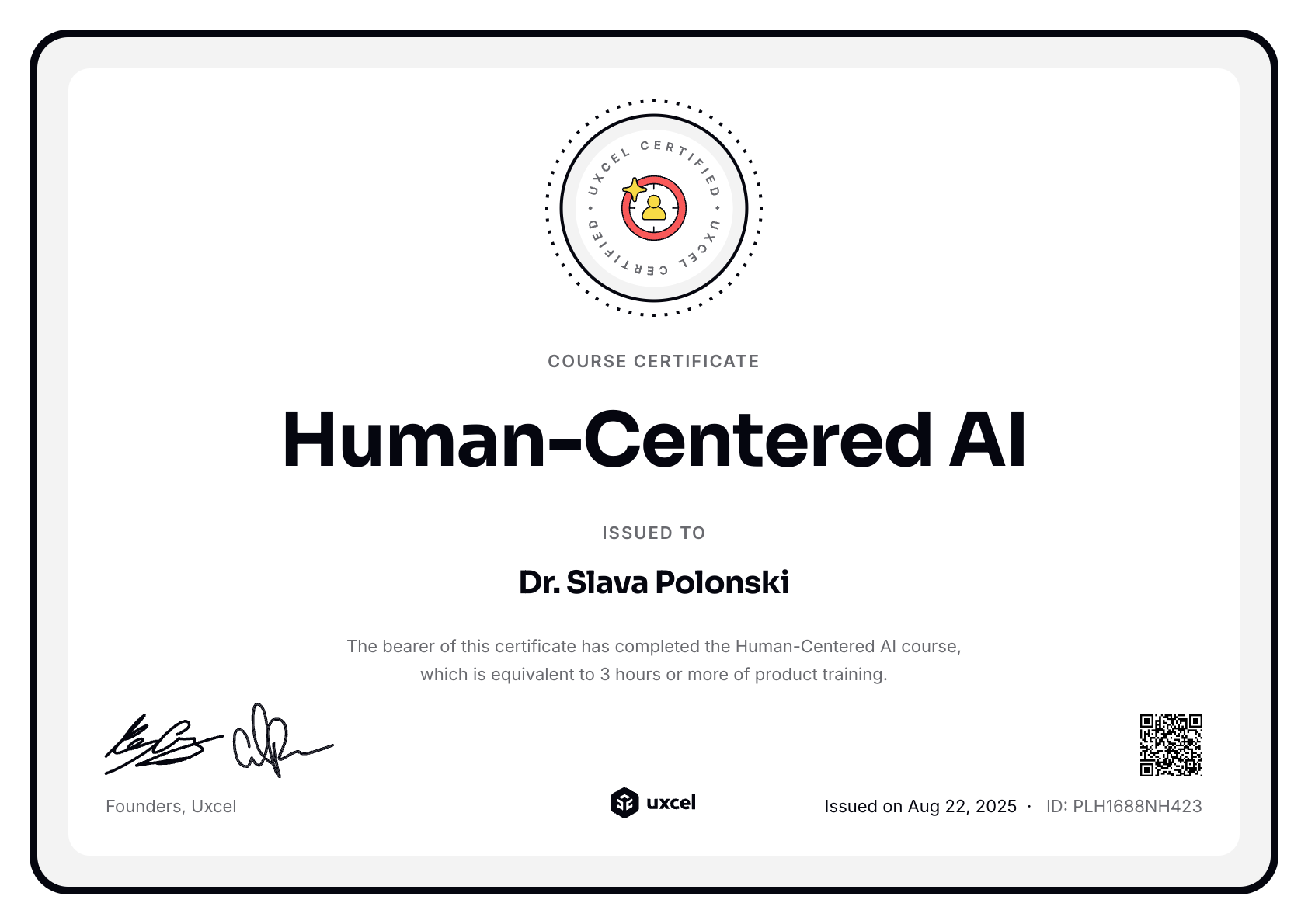Human-Centered AI
Learn AI design principles to create user-centered, trustworthy, and effective AI experiences.
About this course
AI is transforming digital products, but the real challenge is not the technology. It is still about solving the puzzle of human behavior and needs.
This course teaches you how to design AI experiences that meet real user needs. Whether you are a designer, product manager, developer, or researcher, you will learn what makes AI valuable instead of just impressive.
AI learns, adapts, and makes probabilistic decisions. AI sometimes makes mistakes, and this forces us to rethink how we design. You will explore methods for building trust, handling uncertainty, and making AI behavior clear to users.
Through practical frameworks and examples, you will learn when AI creates value and when simpler solutions are more effective. You will design feedback systems, create mental models that help users, and build products that keep humans in control.
The curriculum covers key areas such as assessing user needs, defining success metrics, designing transparent interactions, and managing errors in a graceful way. You will also discover how to guide AI so it develops responsibly and continues to serve users.
From chatbots and assistants to recommendations and predictions, the principles you will gain apply across AI products. By understanding both the strengths and the limits of AI, you will design experiences that support human abilities and earn user trust.
Details
Prerequisites
Skills you’ll gain with course:
Topics covered
Syllabus
User Needs and AI Value




Level Test
Mental Models and Explanations




Level Test
Feedback and Adaptation




Level Test
Errors and Trust Calibration




Level Test
Earn a certificate of completion

Meet your course instructor

How does AI think—and how can we design for it? And what does “good UX” mean in an AI-first world?
I help people bridge the gap between human intuition and machine intelligence. Whether you're a UX designer curious about AI, or an AI builder who wants to get UX right, my work is all about making that intersection more human, more intentional, and more impactful.
Over the past 7 years at Google, I led user research for Flights and Hotels, diving deep into how people make decisions in complex, high-stakes moments. Along the way, I also contributed chapters and case studies to the People + AI Guidebook that Google launched in 2019.
I’ve taught these principles to UX designers at Spotify in New York, to fellow Googlers in Zurich, and at design conferences like IxDA in Milan. My goal is always the same: to help teams move beyond buzzwords and build AI products that actually work for people.
Stay tuned for my new UXcel course on the UX Fundamentals of AI—where design meets deep tech.
Loved by learners from world’s top companies












Related courses

Prioritization and Roadmapping

Business & Technical Fundamentals for PMs

AI Fundamentals for UX
FAQs
This course shows professionals how to design AI-powered experiences that truly meet user needs. You will learn practical frameworks for making AI clear, reliable, and trustworthy, no matter your technical background. The curriculum covers key topics such as identifying real opportunities for AI, designing transparent systems, creating effective feedback loops, and dealing with AI’s natural uncertainty. Through real-world examples and hands-on exercises, you will develop skills to keep AI products human-centered, whether you are designing interfaces, defining features, implementing systems, or conducting research.
AI is now a part of most digital products, yet many fail because they focus on technology instead of people. This course equips you with skills to design AI that users actually trust and want to use. You will learn how to avoid common pitfalls like unnecessary automation, confusing systems, and loss of user confidence. The frameworks you gain apply to different roles: whether you are a designer shaping interfaces, a product manager defining features, a developer building systems, or a researcher studying user needs. As AI adoption grows, these skills will become increasingly valuable across the industry.
You should know the basics of user experience and have some understanding of how digital products work. You do not need technical knowledge of AI or programming skills, since the course focuses on human-centered principles rather than coding. Having used AI-powered tools such as recommendation systems, voice assistants, or predictive text can help, but it is not required. The course is designed for anyone who shapes how users interact with AI systems, regardless of their role or technical expertise.








